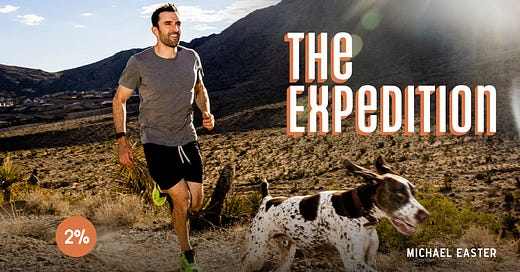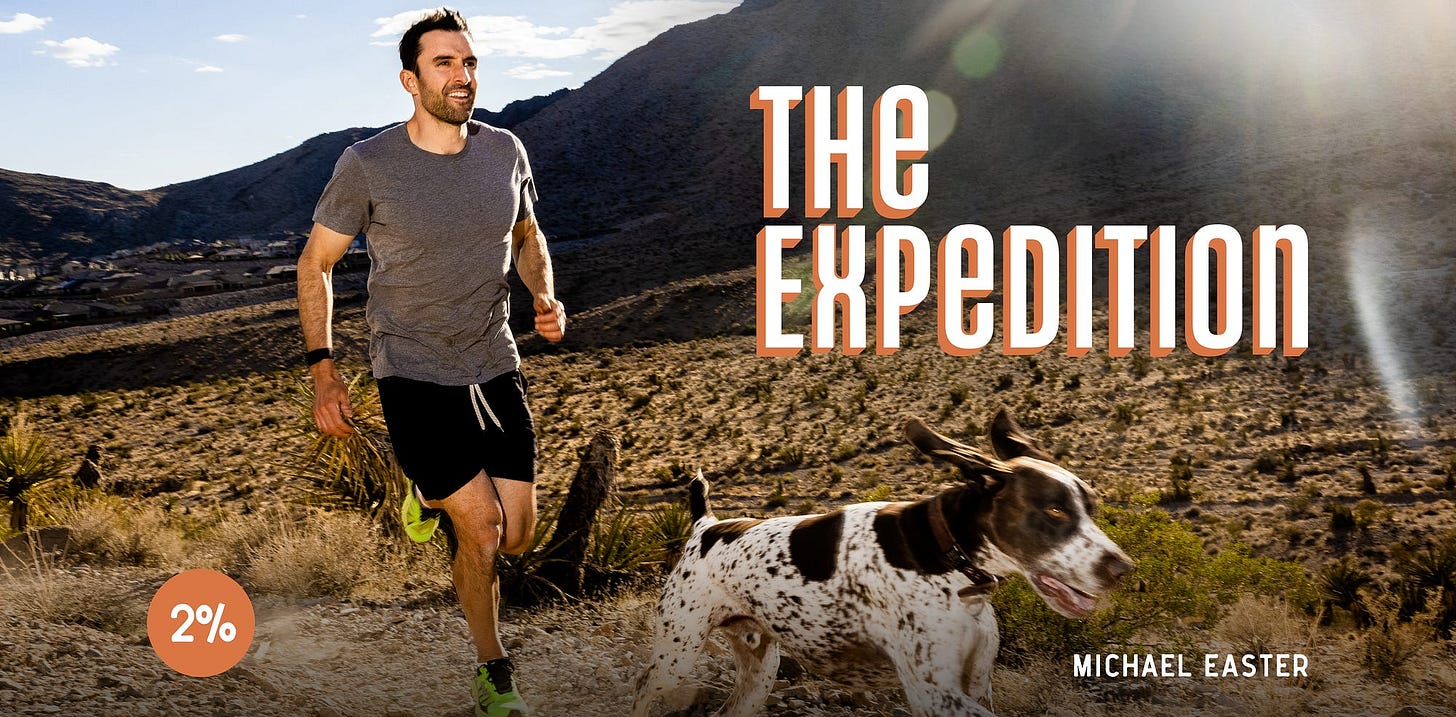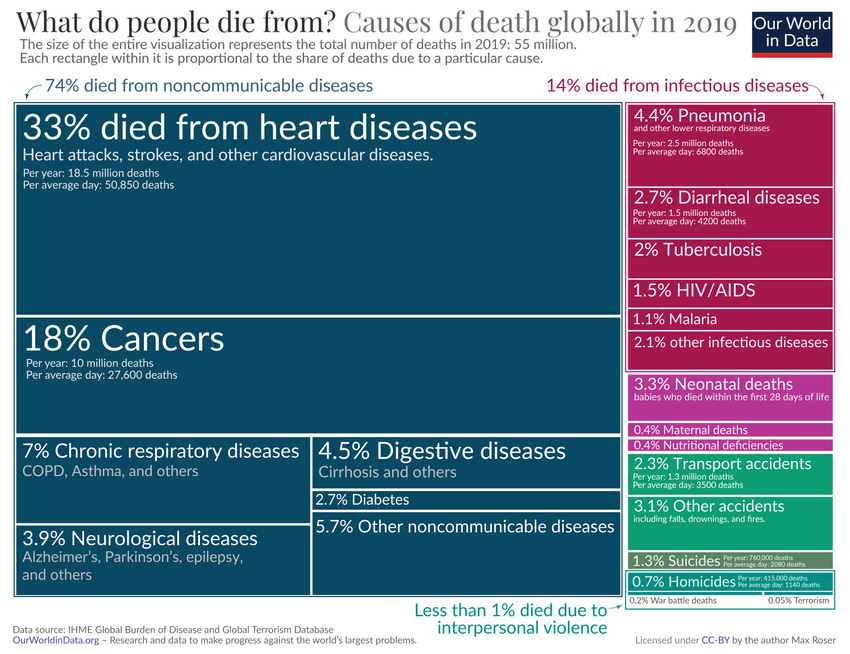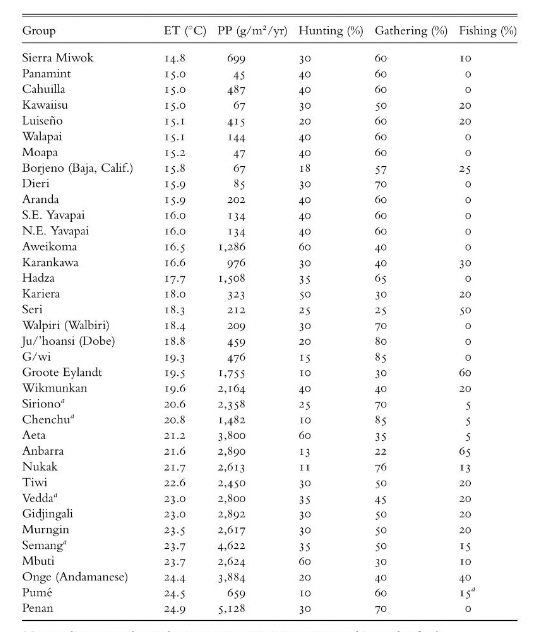The Expedition: February Edition
Bad GPS data, best cross-training exercise, a trick to make healthy food taste incredible, the truth about hunter-gatherer diets, bodybuilders getting outmuscled, and more.
Housekeeping:
Full access to this post is for Members only. Become a Member below to get full access to this post and all of our back catalog.
The Spanish translation of The Comfort Crisis is out as La Trampa Del Confort. Get it wherever Spanish-language books are sold. Like here.
Onto today’s post: The Expedition
This monthly series is a journey into thoughts, opinions, ideas, observations, studies, facts, figures, etc. Good ones, bad ones, insightful ones, dumb ones, and ones you can use to live better.
It’s a roundup of all the worthwhile stuff I’ve encountered in the last month. It’s a bit of an island of misfit toys. But, hey, the greatest journeys are winding.
This month, we’re covering:
Numbers on: 2-Percenter stuff, surviving without water, dudes and feelings, bodybuilders getting out-muscled by climbing bums, etc.
How you’ll die.
The truth about hunter-gatherer diets.
The best cross-training exercise and how to do it.
Is GPS data wrong?
A strange problem with Strava.
A trick from one of the world’s best chefs on how to make healthy food taste good.
Great quotes.
An important parting question.
Let’s roll …
By the numbers
20
Percent reduction in heart disease and stroke risk experienced by people who took the stairs daily. Just five flights a day did the trick.
Be a 2-Percenter.
212
Beats per minute heart rate that Formula-1 drivers hit during a race.
1
Years that scorpions and tortoises can live without water.
Humans, on the other hand, can go about a week, depending on the circumstances.
The data on the topic, however, is murky. We have to extrapolate from accidents where people don’t have access to water for a prolonged period.
30
Percent less socializing Americans did from 2003 to 2022. For teens, the figure was 50 percent.
Here are some stats on what that means for teen mental health—and what to do about it.
107
Percent more likely American women than men are to talk to friends about their mental health.
0
More reps a pair of giant, jacked bodybuilders could perform of a heavy back exercise compared to a scrawny rock climber.
Takeaway: Find a sport. Ideally one that happens outside. You’ll encounter more unpredictable, uncomfortable variables for longer—and you’ll be fitter for it.
10ish
Percent of your exercise that should be all-out, super-hard interval sessions if your goal is to build endurance and optimize long-term health.
How You’ll Die: Visualized
Here are the top causes of death globally in 2019.
You should probably worry most about the blue boxes. Those are what predominantly kill people in developed countries.
In fact, all those blue boxes would have higher percentages if this data only counted developed countries.
You can’t prevent all the diseases in the blue boxes. For example, many cancers are seemingly random.
But you can avoid many of them, like heart disease. I can’t stress how much you should keep heart disease at the top of your medical worries.
How to beat it? Keep reading.
The truth about hunter-gatherer diets
We often think hunter-gatherers are one group of people who all behave the same. They all eat the same kinds of foods and live the same way. But that’s not the case. A classic textbook on Hunter-Gatherers analyzed all the literature on hunter-gatherer diets and found:
The hunter-gatherer diet is variable; we cannot blithely claim that foragers eat mostly plants or that they eat mostly meat.
These data also show that the hunter-gatherer diet is systematically related to environmental characteristics.
For example, here’s a table showing what percent of food comes from hunting versus gathering (plants) versus fishing for a bunch of different groups:
But all these diets have one commonality: All the foods these tribes eat have just one ingredient. Foods with one ingredient are the thread running through the human diet for most of time.
Eating that way can still keep us healthy today. In Scarcity Brain, I traveled to spend time with the Tsimane tribe, who have the healthiest hearts ever recorded by science.
And it all goes back to what they eat. Check out the Two-Week Tsimane Diet Challenge to learn more.
The best cross-training exercise
Got a go-to activity? Great.
Mine’s covering ground in the wilderness. Sometimes I do this light and fast, like when I trail run. Other times I do this loaded down, like when I backcountry hunt.
But if you want to really be good at your favorite go-to activity—whether its CrossFit, triathlons, marathons, pickle ball, whatever—you need a great cross-training activity to compliment it.
This cross-training activity should support your go-to activity, fill your fitness gaps, and decrease your risk of injury.
Think of it as your “side activity” that makes your go-to activity better. It’s like ketchup for your fries. Soy sauce for your sushi. Ice for your cola.
A triathlete recently asked the exercise physiologist Alan Couzens what his top cross-training pick for triathletes and other endurance athletes is.
His response: Cross-country skiing.
Here’s why:
It has minimal impact on your joints, which allows you to do more miles.
It trains your entire body—upper and lower.
It’s a standing exercise, which is generally better for bone density and improving mobility than sitting exercises, like cycling.
It requires enough strength that you can’t get too skinny.
But you also can’t get too heavy because you’re covering distance.
It has huge aerobic demands, so your cardio will skyrocket.
Yes, but who can regularly cross-country ski? I can’t. And neither can you, probably.
I live in a desert, FFS. And snow is seemingly harder to find everywhere these days. Plus, the gear is expensive. Etc, etc, etc.
So what’s the best alternative? Ruck challenging terrain. Ideally a trail.
Use poles if you want more upper-body work as you go.
Is GPS tracking wrong?
This week, we learned how many fitness tracker metrics like steps and made-up activity scores are some degree of wrong (read more here). But here’s a wacky observation I recently made:
Your GPS data may also be wrong.
I recently updated my phone’s home screen. And there’s this little widget I can put on the main screen that shows me my weekly Strava mileage.
It’s a nice reminder to run or ruck the weekly amount of miles that Harvard researchers told me is ideal for humans. (Read Harvard’s Running and Rucking Prescription here.)







